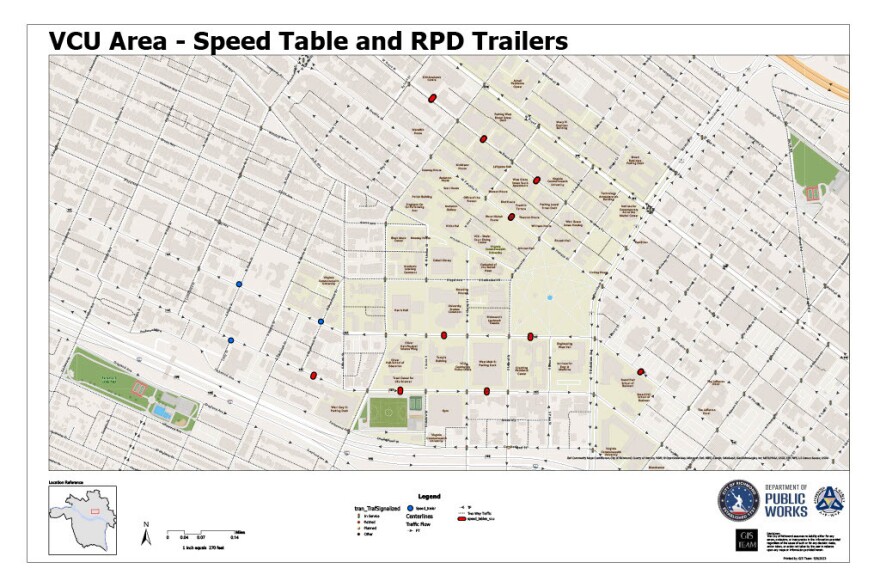Richmond’s Department of Public Works has begun work to install 10 speed tables to slow cars down on four major streets around Virginia Commonwealth University’s Monroe Park campus.
The changing infrastructure impacts West Main, Cary, Grace and Franklin streets between South Belvidere and Harrison streets. Another speed table will be installed on East Main Street near where a car killed VCU graduate student Shawn Soares on the sidewalk.
Speed trailers are also being installed on West Main at the corners of Brunswick and Plum streets. A third will be placed on the corner of West Cary and Lady streets. These devices come in a few forms, from the speed limit radar sign that flashes when certain speeds are exceeded to electronic signs that flash cautionary messages to slow down.
VPM News reached out multiple times to the Richmond Police Department for confirmation and comment on the types of signs that will be used at these locations and for how long. RPD did not respond before publication.
West Main Street between Belvidere and Harrison sees a daily average of more than 17,000 cars, according to the Virginia Department of Transportation.

The DPW project comes in the wake of two fatal pedestrian-related traffic accidents on or near campus.
VCU student Mahrokh Khan, 22, was killed on West Main Street in January. After grad student Shawn Soares’ death on May 5, VCU President Michael Rao sent a letter to the community calling for major street infrastructure changes.
Following Khan’s death the nonprofit media group Strong Towns, which advocates for safer streets, held a crash analysis seminar and suggested the city and college could quickly enact road improvements, such as removing one lane on West Main Street by placing temporary, large orange barrels to slow traffic.
Part of the changes Rao called for include installing traffic-slowing devices like speed tables, which can reduce car crashes by up to 64%, according to the U.S. Department of Transportation’s Federal Highway Administration.
Unlike speed bumps — which you’d see in mall parking lot — or a speed hump (which are designed for residential streets), speed tables allow for cars to travel a bit faster over them than they would over a speed hump, according to the FHA.
Richmond Mayor Levar Stoney told VPM News that $21 million in the recently passed fiscal 2024 budget will go toward traffic calming efforts.
“We're talking about speed bumps and bump outs; we're talking about paving our roads and creating more sidewalks,” said Stoney. “But we have to focus on calming traffic down.”
The mayor said part of that also includes investing in more police enforcement and more public education but added that drivers need to be held accountable.
“We need to slow down everywhere,” he said. “If you're in a city, if you're on the Manchester Bridge, if you're on Patterson Avenue, if you're on Main Street, if you're on Broad Rock Boulevard. This is not a racetrack.”
Stoney also told VPM News that city streets and sidewalks are safer than they have been, but: “We cannot speed bump our way out of this, we cannot enforce our way out of this, we can’t educate our way out of this. But at the end of the day, what we can do is do everything we can change the culture and keep people safe.”
Work on installing the speed tables will last until May 25.



